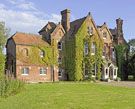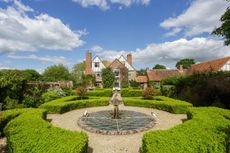Romancing Old Rectories
Three former rectories with fine historic elements are coming onto the market this week


Everyone loves an old Georgian rectory, but few are as romantic as timeless, Grade II*-listed Fountain House at Frome, Somerset, which, with its classical 18th-century façade and exquisitely proportioned rooms, could have stepped straight from the pages of a Jane Austen novel. Set in an acre of tranquil walled gardens in Goulds Ground, a quiet backwater at the heart of this picturesque former wool town on the eastern slopes of the Mendips, Fountain House was originally the rectory to Holy Trinity Church. The charming stone house was listed by a national broadsheet among the top 10 of ‘an absurdly long list of gorgeous West Country properties’ when it last came to the market in March 2007, at a guide price of £1.25 million through Savills in Bath (01225 474550). Its stylish façade was also copied in the design of a new mansion featured in the TV series Grand Designs.
At the time, historical crime writer David Dickinson and his wife, Elizabeth, an international educational consultant, were looking to move out of London and scale down their work commitments. On seeing Fountain House, the high-powered duo was struck by a coup de foudre and swiftly completed the deal in the face of stiff competition, selling agent Andrew Cronan reveals. Two years on, the Dickinsons’ work commitments have actually increased, so they’ve decided to move back to the capital, despite the relatively easy commuter connections linking Frome with central London. And Fountain House is back on the market with Savills, at a realistic guide price of £1.1m.
This time round, Fountain House is still way up there in terms of the best houses currently for sale in the South-West, a marketplace that has shrunk dramatically in both quality and quantity. ‘The problem is that prospective vendors of good houses are in no hurry to sell. If they have a mortgage, it isn’t costing them much to service it, and if they haven’t, they don’t know what to do with the proceeds of a sale,’ Mr Cronan explains. But however you look at it, this Georgian gem, with its three fine reception rooms, Shaker-style kitchen/breakfast room, six bedrooms, three bath/shower rooms and heated outdoor pool, is likely to set a new benchmark for family country houses in this unspoilt corner of Somerset.
Down in deepest Dorset, the long-term owners of Fontmell House at Fontmell Magna, near Shaftesbury, now in their eighties, are downsizing after 47 years in residence. The Victorian house in Parsonage Street was built in 1871 as the rectory to St Andrew’s Church, and remained in use by the Clergy until 1954, when it was sold off and renamed Fontmell House. The former rectory was closely linked with the Fontmell Manor estate, which passed from control by Shaftesbury Abbey into the hands of the Arundell family of Wardour Castle, following the Dissolution of the Monasteries. Thereafter, the manor passed to the Glyn family, but after the First World War, the then squire, Sir Richard Fitzgerald Glyn, sold off most of the farmland and village of Fontmell Magna, with the exception of the church, the rectory and other ecclesiastical properties.
The brick-built house, which is unlisted, stands in more than 10 acres of gardens, grounds and paddocks, and has a hall, four reception rooms, a playroom, a kitchen/breakfast room, seven bedrooms and two bathrooms, plus a coach-house courtyard with garages, stalls and stabling for four. The garden borders farmland to the south-east and historic rectory parkland to the south-west. ‘Fontmell House, which is in good order although in need of some modernisation, is a good family house, and extremely well placed for Dorset’s excellent schools,’ says selling agent Simon Barker of Knight Frank (01935 812236), who quotes a guide price of £2m.
The Old Rectory at Newick, between Haywards Heath and Lewes, is the first flagship house to hit the market in Sussex this year, claims selling agent Tim Page-Ratcliff of Strutt & Parker (01273 475411), who quotes a guide price of £4.5m for the late-18th-century former rectory, which has substantial Victorian additions. He knows it well, having previously sold it in 1994, and again, in 1999, to the present owners. Having decided to down-size, they’ve bought a smaller house nearby, which they’ve demolished and replaced with a new one.
The ancient settlement of Newick pre-dates the Domesday survey, although it’s not recorded in it, possibly because the village was, in those days, buried deep in the Ashdown Forest. Certainly, there was a church here in the 11th century, part of which can be found in the wall of the present parish church of St Mary’s, to which the Old Rectory formerly belonged. The Old Rectory, listed Grade II, is the southernmost property within Newick’s conservation area, whose buildings span nine centuries of English history.
Sign up for the Country Life Newsletter
Exquisite houses, the beauty of Nature, and how to get the most from your life, straight to your inbox.
Built of mellow red brick under a gabled clay-tiled roof, the 9,881sq ft house has been imaginatively renovated and refurbished with no expense spared. There are five reception rooms, a luxurious master suite, seven further bedrooms, four further bathrooms, a state-of-the-art Bulthaup kitchen, a nursery, and a vast lower ground floor with a wine store, billiard room and fitness suite. There are also some admirable 18th-century elements, including fireplaces, moulded cornices, original window shutters and polished wooden floors.
The main façade faces east across the sweeping Low Weald of Sussex, its 10 acres of well-planned gardens and grounds providing a suitably splendid setting for the house, and the pièce de résistance: a breath-takingly beautiful walled garden created by Chelsea specialist Christopher Bradley-Hole.
Country Life is unlike any other magazine: the only glossy weekly on the newsstand and the only magazine that has been guest-edited by HRH The King not once, but twice. It is a celebration of modern rural life and all its diverse joys and pleasures — that was first published in Queen Victoria's Diamond Jubilee year. Our eclectic mixture of witty and informative content — from the most up-to-date property news and commentary and a coveted glimpse inside some of the UK's best houses and gardens, to gardening, the arts and interior design, written by experts in their field — still cannot be found in print or online, anywhere else.
-
 From California to Cornwall: How surfing became a cornerstone of Cornish culture
From California to Cornwall: How surfing became a cornerstone of Cornish cultureA new exhibition at Cornwall's National Maritime Museum celebrates a century of surf culture and reveals how the country became a global leader in surf innovation and conservation.
By Emma Lavelle Published
-
 18 magnificent homes for sale from £550k to £20 million, as seen in Country Life
18 magnificent homes for sale from £550k to £20 million, as seen in Country LifeFrom a charming thatched cottage to a 300-acre estate with its own vineyard, here's our pick of places to come to the market via Country Life of late.
By Toby Keel Published
